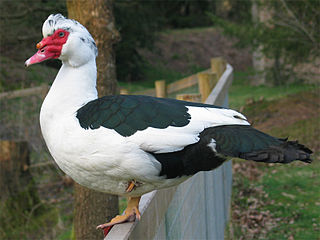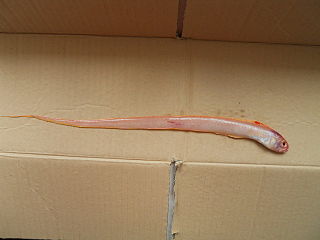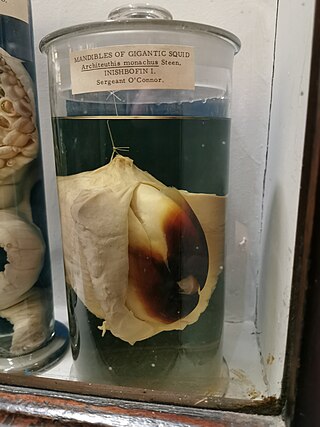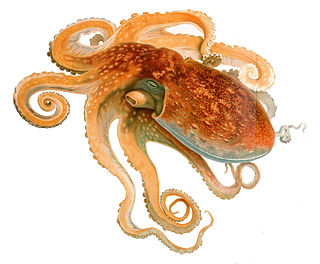
An octopus is a soft-bodied, eight-limbed mollusc of the order Octopoda. The order consists of some 300 species and is grouped within the class Cephalopoda with squids, cuttlefish, and nautiloids. Like other cephalopods, an octopus is bilaterally symmetric with two eyes and a beaked mouth at the centre point of the eight limbs. The soft body can radically alter its shape, enabling octopuses to squeeze through small gaps. They trail their eight appendages behind them as they swim. The siphon is used both for respiration and for locomotion, by expelling a jet of water. Octopuses have a complex nervous system and excellent sight, and are among the most intelligent and behaviourally diverse of all invertebrates.

The Muscovy duck is a duck native to the Americas, from the Rio Grande Valley of Texas and Mexico south to Argentina and Uruguay. Feral Muscovy ducks are found in New Zealand, Australia, and in Central and Eastern Europe. Small wild and feral breeding populations have also established themselves in the United States, particularly in Florida, Louisiana, Massachusetts, the Big Island of Hawaii, as well as in many other parts of North America, including southern Canada.

Iridescence is the phenomenon of certain surfaces that appear gradually to change colour as the angle of view or the angle of illumination changes. Iridescence is caused by wave interference of light in microstructures or thin films. Examples of iridescence include soap bubbles, feathers, butterfly wings and seashell nacre, and minerals such as opal. Pearlescence is a related effect where some or most of the reflected light is white. The term pearlescent is used to describe certain paint finishes, usually in the automotive industry, which actually produce iridescent effects.

Enteroctopus is an octopus genus whose members are sometimes known as giant octopuses.

Octopus is the largest genus of octopuses, comprising about 100 species. These species are widespread throughout the world's oceans. Many species formerly placed in the genus Octopus are now assigned to other genera within the family. The octopus has 8 arms, averaging 20 cm (8 in) long for an adult.

Eledone is a genus of octopuses forming the only genus in the family Eledonidae. It is mainly distributed in the northern and southern Atlantic Ocean, with one species, E. palari, described from the southwestern Pacific Ocean and eastern Indian Ocean in waters around Indonesia and Australia and another, E. microsicya, from the western Indian Ocean. One species, E. thysanophora, is now regarded as a synonym of the brush-tipped octopus.

Velodona togata is a species of octopus in the monotypic genus Velodona. First described by Carl Chun in 1915, with a second subspecies discovered by Guy Coburn Robson in 1924, it was named for the distinctive membranes on its arms.

Cepola macrophthalma is a species of marine ray-finned fish belonging to the family Cepolidae, the bandfishes. It is found in the eastern Atlantic and Mediterranean from Senegal north to the British Isles. This species is known as the red bandfish, though this name is also given to other members of the genus Cepola.

Eledone schultzei, the brush-tipped octopus, is a rare species of octopus. It has previously been known by other taxonomic names (synonyms) including Eledone thysanophora and Aphrodoctopus schultzei.

Pachygrapsus marmoratus is a species of crab, sometimes called the marbled rock crab or marbled crab, which lives in the Black Sea, the Mediterranean Sea and parts of the Atlantic Ocean. It is dark violet brown, with yellow marbling, and with a body up to 36 millimetres (1.4 in) long. A semiterrestrial omnivore, it feeds on algae and various animals including mussels and limpets.

Eledone moschata, the musky octopus, is a species of octopus belonging to the family Octopodidae.

All extant cephalopods have a two-part beak, or rostrum, situated in the buccal mass and surrounded by the muscular head appendages. The dorsal (upper) mandible fits into the ventral (lower) mandible and together they function in a scissor-like fashion. The beak may also be referred to as the mandibles or jaws. These beaks are different from bird beaks because they crush bone while most bird beaks do not.

The curled octopus, also known as the horned octopus, lesser octopus or northern octopus, is a species of cephalopod found in the northeast Atlantic, ranging from Norway to the Mediterranean, including the British Isles. The total length of an adult is around 50 cm, but their arms are often tightly curled. It immobilises and eats large crustaceans by drilling a hole through their shell. It is mainly by-catch in commercial fisheries of the north eastern Atlantic and Mediterranean, where the common octopus is the preferred species.
Eledone palari, commonly known as the spongetip octopus, is a species of benthic octopus from the coastal waters of the eastern Indian Ocean and the south-western Pacific. The species was formally described in 1992 and is the first species of the genus Eledone to be discovered which is not distributed in the Atlantic Ocean.
Eledone massyae, the combed octopus, is a small benthic octopus found off the Atlantic coasts of southern South America, particularly Argentina and southern Brazil.
Eledone gaucha is a species of octopus from the southern Atlantic Ocean. It is a predator of fish, crabs, lobsters and molluscs.

Alphonse Amédée Trémeau de Rochebrune was a French botanist, malacologist and a zoologist. He was born on 18 September 1836 in Saint-Savin, and died on 23 April 1912 in Paris.
Sepia trygonina, the trident cuttlefish, is a species of cuttlefish in the genus Sepia from the Red Sea and the western Indian Ocean. They are also a major source of food for larger marine life like dolphins, seals, and even birds.
Eledone caparti is a rare and little known species of benthic octopus from the Atlantic Ocean off the south-west coast of Africa. The egg masses of Eledone caparti have been found in the dissected stomachs of blue sharks.

Tonicia is a genus of chitons in the subfamily Toniciinae of the family Chitonidae.














